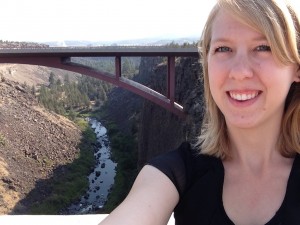Where were you born and where do you call home?
I was born in Greensboro, NC but didn’t live there long. I call Eugene my west coast home, but Blacksburg, VA my hometown. “Hometown” is a bit of a stretch though, considering I attended 16 different schools before 9th grade. That’s my fun fact about myself.
What’s your favorite pig-out food?
I LOVE the fries from Falling Sky, a brewery restaurant that is located way too close to my house for my cholesterol health. I’m also guilty of occasionally eating ice cream for breakfast.
In which graduate program are you enrolled?
I’m working towards my Master of Community and Regional Planning and focusing on the mitigation of natural disasters, particularly those related to climate change. I’m also finding a strong interest in identifying ways organizations can reduce their greenhouse gas emissions though conducting GHG Inventories and life cycle assessments.
What Community Service Center program(s) are you working with?
Up till now, I’ve worked with the Community Planning Workshop, which has been the best experience of my program thus far. My CPW project, which I continued into the summer, was for the Oregon Partnership for Disaster Resilience (OPDR). The Oregon Partnership for Disaster Resilience (OPDR) is an applied research program working toward the mission of creating a disaster resilient and sustainable state.
What are you doing for the Community Service Center (CSC)?
I worked on a team that updated the Jefferson County Natural Hazards Mitigation Plan (NHMP), which forms the foundation for a county or city’s long-term strategy to reduce disaster losses and break the cycle of disaster damage, reconstruction, and repeated damage through hazard mitigation. Hazard mitigation is any sustained action taken to reduce or eliminate long-term risk to people, property and the local economy. NHMPs must be updated every five years in order to stay compliant with FEMA requirements. Over the summer I developed a final draft of the Jefferson County Natural Hazards Mitigation Plan (NHMP), which was pre-approved by FEMA on December 10th of 2013 and is now awaiting city and county adoption. Currently I’m assisting with the update of the Oregon NHMP and will soon be involved with the creation of a NHMP update training series for local officials.
How does your involvement with the Community Service Center relate to or inform your education?
My work on this project introduced me to the field of planning for natural disasters, which greatly interests me, partially how it relates to climate-related natural disasters that can affect planning such as sea level rise.
What did you get for your birthday?
My dad sent me a new hiking pack filled with everything I could possibly need to track down and find Big Foot. It’s been a running joke that instead of moving to Oregon for school, I was really on a journey of self-discovery, which involved finding Sasquatch.
Where can we ‘cyber-stalk’ you?
LinkedIn: http://www.linkedin.com/in/stacyludington

